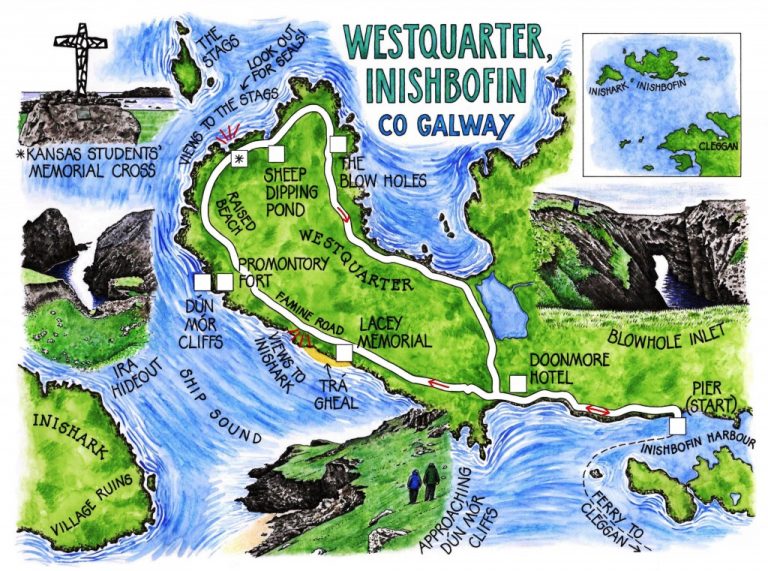Irish Independent – WALK OF THE WEEK – Christopher Somerville
17 July 2010
67. Westquarter, Inishbofin, Co. Galway

The long black currachs strained at their buoys in Inishbofin harbour, their retroussé noses snubbing the lines as a stiff west wind blew in from the Atlantic. A saucy cockerel screeched defiantly from his gatepost lookout, and purple orchids trembled in the breeze along the verges of the lane. Grey or fine, windy or still, Connemara exerts magic on its visitors, especially out in these humpy granite islands of the west. We were lucky to be walking Inishbofin with Gerry McCloskey, a man who has forgotten more about the islands than I’ve ever imagined learning.
The bare soil of Connemara’s island fields has always needed to be painstakingly manured, cultivated and carefully preserved from blowing away. We passed a neat and tiny vegetable garden, the heaped ridges growing carrots, onions, lettuces, beetroot, spuds, all buttressed from the salt sea wind by sturdy stone walls. Out along the grassy track to the townland of Westquarter, the fields tended by former generations lay thick on either hand, corduroy ridges combed in parallel lines down slopes too steep and awkward for any horse plough.
Inishbofin is an island that holds its history close to the surface, to be read by anyone with a pair of eyes and a little curiosity. This rollercoaster of a track, leading out to the islanders’ turf banks at the west end of Inishbofin, was built by hungry men and women as a famine road when all their sweat and labour at the potato beds turned futile overnight. There was fish, of course, but the sea was hungry, too, and it never lost its propensity to swallow men and currachs. The cliffs of Westquarter hold poignant memorials – a striking skeletal cross to Edward Moll and Richard Mathes, two Kansas students drowned while swimming, and above the beautiful creamy sands of Trá Gheal a memorial to three boys of the Lacey family, brothers Michael and Martin and their cousin Peter. All three were lost in 1949 when their currach tipped over on Easter Sunday morning as they rowed from their native Inishark to attend Mass on Inishbofin.
Inishark had no priest. The island lacked a doctor, too, and a decent harbour. When a young man died of appendicitis because help could not be fetched in time, it spelled the end for human life on Inishark. Looking across the quiet sands and the restless waters of Ship Sound to the roofless ruins of Inishark’s village, imagination saw the final exodus by boat of the remaining couple of dozen islanders in 1960. They went to houses and land in Claddaghduff; their homeland entered a long isolation, still unbroken.
We turned down along crags of red shaly rock, moving across slopes where brisk little birds went skimming away, flashing their snowy rumps. They were wheatears, a politer bird-fancier’s version of the earthy old name that countrymen knew them by – ‘white-arse’.
The massive stone blocks of Dún Mór promontory fort clung to a green, upslanted tongue of cliff. Beyond, Gerry showed us the scoop of ground where IRA men on the run would hide from soldiers searching the island during the War of Independence. Here lies a rough and stony region, exactly resembling a beach of shingle pebbles. That’s just what it was, confirmed Gerry – a raised beach, left high and dry after the Ice Age glaciers melted. All that weight of ice was lifted, and the land rose up like a sponge that had been squashed under a giant foot.
The Kansas students’ memorial cross looks north towards the islets of The Stags. This is the westernmost and remotest quarter of Inishbofin, seething with the wildly tossing heads of bog cotton. We walked on, circling round the cliffs. Two enormous blowholes opened at our feet, each big enough to sink a ship in, connected by a passageway through the canted rock strata that opened to the sea. In a northerly gale the holes spew spray with a boom to frighten the devil. But today they lay quiet, in harmony with the mood of this soft grey afternoon on the western threshold of Ireland.
WAY TO GO
MAP: OS of Ireland 1:50,000 Discovery 37; downloadable map/instructions (highly recommended) at www.discoverireland.ie/walking; map-guide available on Inishbofin.
TRAVEL:
Bus (www.michaelneecoaches.com; www.citylink.ie): Galway-Cleggan
Road: Cleggan is signed from N59 between Letterfrack and Clifden
Ferries: Island Discovery (095-45819/45894; www.inishbofinislanddiscovery.com), King Ferries (095-44649) from Cleggan to Inishbofin
WALK DIRECTIONS: Bear left from pier along road past Doonmore Hotel; where tarmac ends, follow famine road and waymarked paths clockwise around cliffs. At sheep-dipping pond (beyond memorial cross to Kansas students) waymarks run out; aim for skyline near coast to continue, following coast back to hotel and pier.
LENGTH: 5 miles: allow 3 hours
GRADE: Moderate
CONDITIONS: Grass paths; one or two slopes; can be slippery after rain. Buggy-friendly along roads. NB Cliff edges are unguarded and sheer – please take great care, especially with children and dogs!
DON’T MISS … !
• views over Trá Gheal to Inishark
• Kansas students’ memorial cross
• the blow holes
REFRESHMENTS/ ACCOMMODATION: Doonmore Hotel (095-45814/04; www.doonmorehotel.com); Day’s Hotel (095-45809; www.dayshotel.ie); Dolphin Hotel & Restaurant (095-45991; www.dolphinhotel.ie); Galley B&B and Restaurant (095-45894); Lapwing House (095-45996)
GUIDE BOOKS/LEAFLETS: Map-guide widely available on Inishbofin
OPERATOR: Connemara Safari Walking Holidays (Gerry McCloskey: 095-21071 or Freephone 1850 777 200; www.walkingconnemara.com)
INFORMATION: www.inishbofin.com
WALKING in IRELAND: Walking tour operators, local walks including Discover Ireland’s National Loop Walks, walking festivals throughout Ireland: www.discoverireland.ie/walking.
Barnardos Full Moon fundraising walk, 24 July: meet Glenmalure Lodge, Wicklow, 3 p.m., for barbecue followed by walk. Details: Katherine Thomas, 01-708-0450; www.barnardos.ie
csomerville@independent.ie